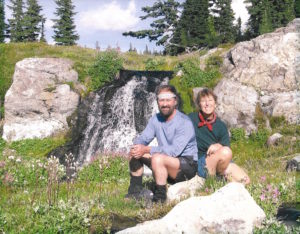Sheila Signer devoted her working life to the development of infants and toddlers. She also has a passion for singing/songwriting, world travel and photography. Sheila has Benson’s syndrome, a rare form of Alzheimer’s that affects visual processing. She shares her first experience of how the disease would affect her lifelong passion for traveling.
 [6]I first met Mel 37 years ago in a raging storm on the island of Kauai, where we were both rained out on our hikes along the Kalalau Trail. Mel was a cheery, well-equipped hiker and generously shared both his gear and a mood uplifting smoke””remember: this was the Seventies! Laughing off our disappointment, we spent a soggy night on the North Shore before heading west the following day to Polihale Beach, where it’s always warm and dry.
[6]I first met Mel 37 years ago in a raging storm on the island of Kauai, where we were both rained out on our hikes along the Kalalau Trail. Mel was a cheery, well-equipped hiker and generously shared both his gear and a mood uplifting smoke””remember: this was the Seventies! Laughing off our disappointment, we spent a soggy night on the North Shore before heading west the following day to Polihale Beach, where it’s always warm and dry.
It was clear to both of us that we had made a new friend who loved to be in nature, and we made a pact to hike together every year from then on. I lived in northern California and Mel nearly a thousand miles north in Washington, close to the glorious Cascades. We had a world of beauty to explore, one year at a time. I traveled north every summer for 33 years to backpack with my friend Mel.
On what was most likely our last trip, although I didn’t know it then, Mel and I were going to Mount Adam, a peak with two crowns and views of Mount St. Helens shrouded in cloud. At first the hike up with full packs was exciting, but after a couple of hours, as the trail grew rockier, it began to feel grueling. The steep trail had always been strenuous but now I had a new challenge: my deteriorating vision, in which I was losing the ability to see what was close, made it hard for me to see where to place my feet. I could still take in the sweeping beauty of nature but not the rocks beneath my feet.
Like a whiny child, I was asking how far we had to go. I let my pack pull me to the ground and refused to move. While Mel patiently waited, I drifted into a gentle snooze for a few minutes until he cracked the whip and insisted, because of the fading daylight, that we carry on. That little nap seemed to help. I knew there was no alternative but to keep hiking upward, and I fastened my attention on the beautiful fields of blue lupine, red paintbrush and the snowy peaks, sustained by an occasional blueberry plucked off a bush.
Mel helped by carrying my pack for the final stretch of the trail. I took in the magical site (at about 5000 feet) that would be our home for the next four days. It was a secluded meadow with a burbling stream that kept us company and provided water for an icy bath. Nearby, an easy walk from camp, a stream trickled down from the snow with pristine water for cooking and drinking.
As the growing dusk fell around us, Mel put up my tent and boiled the water in which to cook our freeze-dried food. I did what I could to help but was sharply aware of my rapidly fading vision, of this difficulty I had, not only to see what was close but also to see in the dark. Bundled up in the cold, starry night, we savored each morsel of our meal and vowed we would do this for as long as we could. How we treasure our years of joyful discomfort!
After four days and nights of beauty, Mel and I returned to the everyday and our homes. We knew things were changing, but we didn’t know how much.
Helpful information related to this post:




